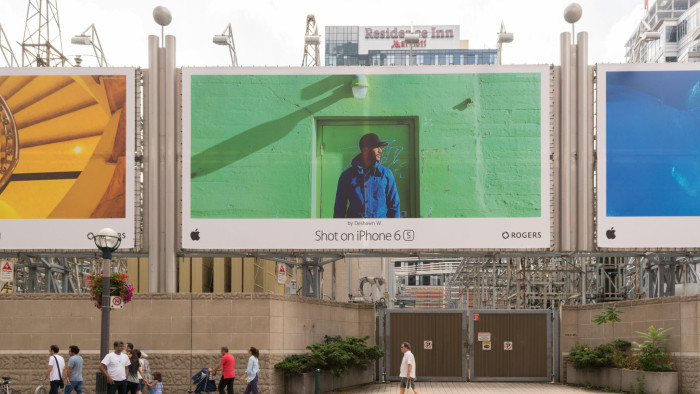Gig economy’s new deal for Silicon Valley’s white-collar workers

Simply sign up to the Gig economy myFT Digest -- delivered directly to your inbox.
Legislation in California is threatening the future of the “gig economy” for low-paid work such as driving with Uber or couriering hot meals. Yet flexible hours, on-demand work and other key tenets of the gig economy are now shaking up careers in white-collar work.
The number of American workers in this alternative workforce — comprising contractors, outsourced teams, freelancers and gig workers — will have tripled to 42m this year since 2017, estimates Deloitte, the professional services firm.
The trend is encouraged by the likes of Working Not Working, a New York-based platform for freelancers, and California-based UpWork, which specialises in on-demand gigs that can be done remotely.
Younger workers are behind the push. Deloitte found that only 6 per cent of millennials — aged mid-twenties to mid-thirties — had actually “chosen to be part of the gig economy instead of working full time”. But more than 10 times that figure said they would “take gig assignments to supplement existing employment”. Top reasons were earning more money, having flexibility and achieving a better work-life balance.
Andrew Schwedel, a consultant at Bain, calls this “the new deal for talent”. He says: “The old deal of climbing up the hierarchy — the way you’re rewarded with more titles, perks, and bigger teams to manage — that’s not relevant for the winning companies today.” Instead, younger workers want to set their own schedules and accumulate new skills on their terms.
“They don’t want a fake ribbon — they want something to take back and put on their LinkedIn profile,” adds Pat Wadors, chief talent officer at a cloud software company ServiceNow. “There’s a whole new frontier of technology that’s emerging to tap into that pool of talent. How to connect with them, reward them.”
For companies, the attraction of this new deal is simple: they can keep a smaller core staff of regulars and augment the team when needed, without having to offer permanent contracts.
IT professionals, artists and other creative types are taking the lead. Liem Hua, head of strategic sourcing at data platform LiveRamp, who ran Apple’s contingent workforce programme for five years, says the white-collar gig economy in Silicon Valley “is massively important” to tech giants. “They fill the gamut at not just Apple but all the tech companies.”
Big recruitment agencies have long played a role in helping to staff creative teams at tech companies. Now, project work is proliferating with the help of lower-cost apps and virtual agencies.
At Apple, a move to bring more of its creative work in-house was blamed for lay-offs in November at Omnicom Group-owned Media Arts Lab, the agency behind famous Apple campaigns, such as the “Shot on iPhone” billboard ads. But Apple increasingly relies on a core internal team coupled with a rotating group of freelancers.

Joel Godfrey understands this shift first-hand. When Apple acquired headphones maker Beats by Dr Dre in 2014 for $3bn, its biggest acquisition, it hired Mr Godfrey as head of creative delivery to build a product management team.
He found that the iPhone maker was paying 50-100 per cent premiums via recruitment agencies for temporary workers to create the sort of ads used in a Best Buy store.
“Our relationship with the agencies wasn’t a healthy one. We were spending millions of dollars and there was a mark-up on everyone we were working with,” Mr Godfrey says.
He brought the creative team in-house by sourcing freelancers directly. He has since left Apple to launch Double O, a business to help companies manage similar transitions. “By the time I had left [our team was] doing way more,” Mr Godfrey says.
Microsoft has made similar moves. Craig Bradford is a studio producer for the team that runs the strategy and ad campaigns for Microsoft stores, Surface websites and other content.
The team has six full-time people, but it can rise to 20 or more by using agency Aquent to bring in freelancers when needed.
“You get fresh eyes on the subject,” Mr Bradford says. “I can use Aquent for a short-term worker like a story artist, a skill set we don’t always need. I can bring them in for just a week, or they come in for three years. It really does provide that flexibility.”
Aquent combines the best of the gig economy — flexible, on-demand shifts — with benefits such as healthcare that highly paid creatives expect. But as the gig economy expands into new areas, Aquent chief executive John Chuang worries about competing with rivals that do not offer benefits. He says “investors really need to separate out whether [a company] is growing because of a good business model — or because of employee misclassification and an unfair cost advantage.”
At EY, the professional services firm, the importance of on-demand workers has moved from “a lever we could pull five years ago” to “a key part of our strategy,” says Jeff Wong, global chief innovation officer.
In 2017 his team established GigNow, a platform used internally to find contract talent. It is now live in 35 countries, with 36,000 workers registered. “There are all these projects around the world that we couldn’t take on before, but we can now — because now we have a talent base.”
A study from UpWork and the Freelancers Union, the advocacy group, estimated in October last year that annual income in the US freelance economy totals nearly $1tn. For the first time, in six years of such studies, a majority of freelancers viewed their work as a long-term choice rather than as a temporary option.
In-house “gigs” are a way to offer a project that has special relevance for a worker. Emily He, senior vice-president of human capital management at software giant Oracle, says Generation Z is keen to find fulfilment beyond financial rewards and companies risk losing them if they fail to respond.
At Oracle, she says, a marketplace exists for managers to post projects that staff can take on without leaving the company.
“There’s this view that you ‘gig in’ — employees find a side hustle within the company — “or you get out,” Ms He says. “We are providing gigs within the company before they leave.”
Comments